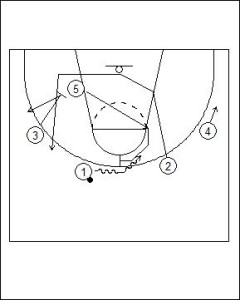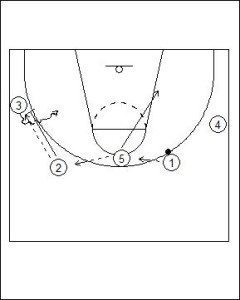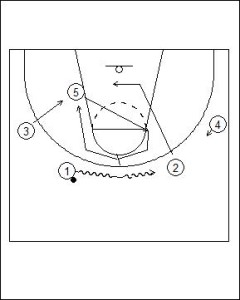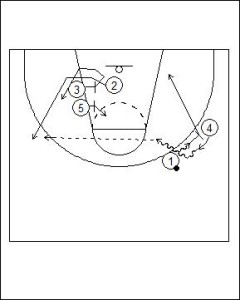4-1 Offense: High On-ball Screen
4-1 Offense formation is a great choice for coaches who do not have a lot of depth within their playing roster for interior targets. This alignment provides good spacing for all players on the court while allowing for short quick passes left or right and into the keyway to the post target. The High On-ball Screen play has been designed for teams looking to add depth to their four out and one in options.
The 4-1 Offense High On-ball Screen provides a number of positives for a team. The first of which is it changes the alignment from four out and one in with the post target in the low post region, to four out and one in with the interior player in the high post. This is a useful tool for teams as it makes the defensive players move away from the basket and the more importantly the keyway. This is especially important for those teams who may be playing against a stronger interior defensive presence and what to draw this player away from help positions and shot blocking opportunities.
The second good point about this play is the number of different elements that are included. Within any offense, the inclusion of a variety of tactics is very important because as long as the offense is well put together, then it is these elements that provide trouble for the defence to deal with. The 4-1 Offense High On-ball Screen includes tactical elements like on-ball screening, shuffle cuts, staggered screens, and continuity on both sides of the floor, which means the defensive players, must constantly be in motion and be technically perfect in their rotations.
The final point of note about the 4-1 Offense High On-ball Screen is the ability for miss-matches to occur. The offense will have a minimum of two on-ball screening elements per possession so these in turn generate opportunities to gain advantages and exploit defensive rotations. The one point of note however is that the offensive players involved in the on-ball screening situations must be well drilled in all possible scoring opportunities out of an on-ball screen or they will not be able to meet the demands of using this tactic effectively, and this could become a threat rather than an opportunity.

Five (5) lifts to weak side high post. Five (5) has an option of setting a screen for Two (2) on the shuffle cut to basket.
Two (2) cuts to the basket and then moves to strong side low post position.
Five (5) moves to the point position and sets an on-ball screen for One (1).
Three (3) down screens for Two (2). Two (2) then moves off the screen and lifts to three point line.
One (1) utilises the on-ball screen while the screening action between Three (3) and Two (2) is happening and then attacks basket.

If no scoring opportunity is available, the ball can be reversed.
One (1) makes initial reversal pass to Five (5) who makes a quick pass onto Two (2). Alternatively, the reversal can be initiated by a skip pass to Two (2) if Five has rolled to the basket follow the screen.
Two (2) continues the reversal to Three (3) and then moves to set an on-ball screen.
Three (3) uses screen to attack basket.
Two (2) will read the movement of the defence an either flare or roll to the basket.

Option 2: Shuffle Cut
Five (5) lifts to weak side high post. Again Five (5) has the option of setting a screen for Two (2) on shuffle cut to basket.
Two (2) cuts to the basket and moves to strong side low post.
Five (5) moves to point position and sets an on-ball screen for One (1). Three (3) moves into low post.
One (1) utilises on-ball screen and continues onto opposite side elbow extended.
Five (5) then rolls to set shuffle cut screen.

One (1) dribbles towards Four (4) and executes either; an on-ball screen following a pass or hand-off with Four (4).
Two (2) shuffle cuts off the staggered double screen and following a read of the defence can either curl, straight or flare cut.
Four (4) attacks the basket following the screen or hand-off. One (1) rolls to basket following screen or hand-off.
Following the screen Five (5) and Three (3) move to receiver spots looking for seal and ball side position for easy passing opportunity.
If pass is made to Two (2) then the scoring options will include: shot, pass to Five (5) or Three (3) in receiver spots.








Leave a Reply